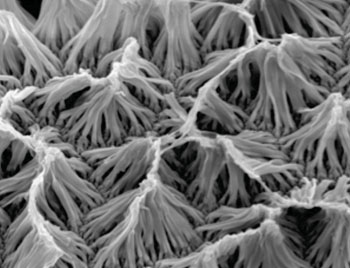Novel Controlled-Release Drug Delivery System Heals Spinal Inflammation in Mouse Model
By LabMedica International staff writers
Posted on 07 Jul 2015
A novel drug delivery system that allows controllable release of an anti-inflammatory agent directly to the site of inflammation or injury was tested successfully in a mouse model.Posted on 07 Jul 2015
Investigators at Purdue University (West Lafayette, IN, USA) developed an implantable device comprising polypyrrole nanowires (PpyNWs) loaded with the anti-inflammatory corticosteroid dexamethasone. Polypyrrole is an inert and biocompatible conductive polymer material that responds to an electromagnetic field by releasing the bound drug.

Image: Scanning electron microscope (SEM) image of a field of polypyrrole nanowires (Photo courtesy of Dr. Richard Borgens, Purdue University).
The investigators lifted a one to two square millimeters patch of dexamethasone-doped PpyNWs onto a single drop of sterile water held by surface tension. The drop was deposited onto a spinal cord lesion in a transgenic mouse that produced a luminescent form of glial fibrillary acidic protein (GFAP). This protein is expressed in astrocytes that gather in high numbers at the site of central nervous system injuries where they take part in the inflammatory process and form scar tissue. In this study, the strength of the GFAP luminescent signal was a marker for degree of inflammation.
The corticosteroid dexamethasone, a powerful ameliorator of inflammation, was released from the PpyNWs by external application of an electromagnetic field for two hours per day for a week.
Results published in the May 12, 2015, online edition of the Journal of Controlled Release revealed that the GFAP signal, measured by bioluminescent imaging in the living animal, was significantly reduced in treated animals. At the end of one week, GFAP was at the edge of detection, and in some experimental animals, completely eradicated. Control animals that did not receive a patch or received a patch that did not contain dexamethasone showed no decrease in GFAP signaling.
"This method allows a very, very small dose of a drug to effectively serve as a big dose right where you need it," said senior author Dr. Richard Borgens, professor of applied neuroscience at Purdue University. "By the time the drug diffuses from the site out into the rest of the body, it is in amounts that are undetectable in the usual tests to monitor the concentration of drugs in the bloodstream."
"This tool allows us to apply drugs as needed directly to the site of injury, which could have broad medical applications," said Dr. Borgens. "The technology is in the early stages of testing, but it is our hope that this could one day be used to deliver drugs directly to spinal cord injuries, ulcerations, deep bone injuries or tumors, and avoid the terrible side effects of systemic treatment with steroids or chemotherapy."
Related Links:
Purdue University













